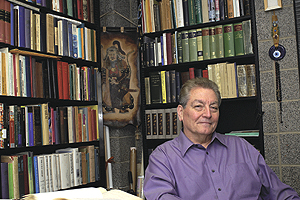2007 Faculty Awards for Excellence in Graduate Teaching: John Woods
By William HarmsNews Office
 John Woods (Photo by Beth Rooney) | |
As a teacher of graduate students, John Woods draws from his past experiences to develop his own personalized methods for teaching.
Woods, Professor in History and the College and a specialist in Islamic and Central Asian history, had one of his first experiences in great teaching at the American Community School in Beirut, where a civics teacher taught him the value of posing questions rather than simply lecturing students and training them to know answers.
Later in graduate school at Princeton University, he worked with his mentor, Martin Dickson, who also challenged his students and encouraged Woods to pursue his interest in the Middle East by learning Persian. “I spent evenings at his home learning Persian. In his classes, we were treated as colleagues, and that is the way I try to treat my students as well,” said Woods, who also is Professor in Near Eastern Languages & Civilizations.
“There are many aspects to graduate teaching, including that professional, mentor role, which can lead to the development of a strong relationship with students. We also model a commitment of respect for the professional as well as personal integrity,” he added.
Woods spent five years at Tehran University working on manuscripts to study Iranian history and Persian language and literature. The experience taught him the importance of meticulous, rigorous work.
“I insist on precision and accuracy in my classes,” Woods said.
That message is seldom lost on his students. In a tribute to his work published in a volume last year, History and Historiography of Post-Mongol Central Asia and the Middle East, Studies in Honor of John E. Woods, Judith Pfeiffer and Sholeh Quinn wrote: “As a teacher, Woods is awe-inspiring, while also directly engaging. He always requires absolute precision. Woods’ blackboards are sights to behold—covered with charts and examples, from modes of military organization to Turkish animal years.”
Woods, who received his Ph.D. in Near Eastern Studies from Princeton University in 1974, began teaching at Chicago in 1970, and he has been teaching some of the same courses, such as Islamic Civilizations, since then. However, his teaching style and his students’ backgrounds have changed over time.
“I find myself using PowerPoint presentations, just because the pictures and other visual examples help me present the material better and keep students engaged,” he said.
The Islamic civilization course is taken by graduate students working toward a master’s degree in Middle Eastern studies as well as by undergraduates. Increased interest in the Middle East has led to a growth in the number of students enrolled in the master’s program, which prepares them for employment in government positions and non-governmental organizations.
“Another change has been the increase in students who come from Islamic backgrounds. That began in the mid-1980s,” he said. That increase has prompted more interesting classroom discussions, such as when students raise questions about the meaning of slavery in Islam.
“I enjoy working with my students very much. I enjoy their enthusiasm and also delight in their discoveries,” he said. Sometimes the delight is tempered by the need for some serious professorial feedback. Students need help narrowing their focus for dissertations, Woods has found, and sometimes they need help with their writing.
“I tell them that there are specific steps in working on a project: One is to identify the topic, the next is to determine the state of the art related to the topic so that they can see what original contribution they might be able to make. Then they must decide what questions have not been asked on the topic. After making a selection of questions, students then should decide what examples best illustrate their points,” he said.
Sometimes that direction is not enough, as students occasionally struggle with writing. Some of those students are encouraged to enroll in the Little Red Schoolhouse program to get tips and practice in writing, but occasionally the guidance they need can come only from Woods himself.
“In a couple of cases, I’ve sat down with students and gone over their dissertations with them, word-for-word, and asked them: ‘Is this what you really mean to say?’ ” These diligent tutorials have worked, and many of Woods’ students have moved on to careers in scholarship, thanks to his patience and skill as a teacher.
![[Chronicle]](/images/sidebar_header_oct06.gif)